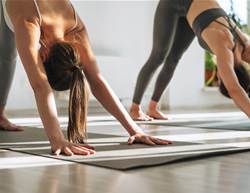Strength training offers big benefits for women over 50, from preventing muscle loss and strengthening bones to supporting brain health. But once you’ve nailed the basics, it’s worth challenging yourself in new ways to keep building both physical and mental strength, says high-performance coach Angela Gargano. One move she recommends? The pull-up.
“I’m obsessed with pull-ups,” says Gargano. She even developed her own program to help hundreds of women—many of them over 50—achieve their first pull-up. While the move can feel intimidating, Gargano insists it’s possible for many women.
Take Jocelyn Klotz, 55, who joined Gargano’s program. “Initially, I wanted to get a pull-up because I thought it was a cool skill to do,” she says. “But it became more about proving to myself and to others that it’s a skill that’s possible to achieve.”
What are the benefits of pull-ups?
“Pull-ups are a compound exercise that work several muscles in the upper body,” says internist Dr Heather Fields. They engage your shoulders, back, arms, and chest.
“I love the fact that we’re working on the upper body, which a lot of women skip,” adds Gargano.
Dr Fields notes that pull-ups are particularly effective for muscle hypertrophy (growth). Like other resistance training, they can help slow age-related muscle loss (sarcopenia) and bone loss (osteopenia/osteoporosis). For women over 50, those benefits are especially valuable. Resistance training also helps lower blood pressure, blood sugar, and cholesterol.
Pull-ups aren’t just physical—they’re empowering.
“When you’re working on a goal and doing something for the first time or doing something that you thought was impossible, it’s going to be mentally challenging,” says Gargano. But the payoff is a serious confidence lift.
“Conquering a pull-up was more than just conquering a pull-up,” says Catherine Plomp, who achieved her first by her 50th birthday. “It gave me so much confidence” in fitness and beyond.
Can women over 50 really do pull-ups?
Yes—though it’s a challenging move, experts agree it’s possible.
“Pull-ups are one of the most demanding resistance exercises, but with the right approach, women over 50 can absolutely do them,” says Dr Fields.
That said, women dealing with sarcopenia (age-related muscle loss), injuries, or long-term health conditions may find it more difficult. “Pain or weakness from tendonitis or arthritis in the neck, back, shoulders, arms, or hands can also be limiting,” Dr Fields adds. If you have pre-existing injuries or health concerns, check in with your doctor before starting.
Working with a trainer or joining a structured program like Gargano’s can also provide the guidance and accountability needed to succeed.
How to get started with pull-ups over 50
Gargano says it’s a myth that you need to be “super strong” before even trying. “As you work up to it, you’re going to be getting stronger,” she explains. The key is combining mobility, stability, and strength training.
“Exercises that build strength in the latissimus dorsi and biceps brachii, along with other supporting muscles, will help you work toward a pull-up,” says Dr Fields. Options include dead hangs or scapular retractions on a bar.
Gargano recommends:
- Assisted pull-ups with bands or a machine
- Lat pull-downs and horizontal rows
- Bicep or hammer curls
- Farmer’s carries for grip strength
- Plank shoulder taps for stability
For Lalita Tamburri, 52, who had dreamed of doing a pull-up since her teenage years, the breakthrough came once she tackled her mindset. “I worked with clearing some of my own mental blocks and my pull-up came very quickly,” she says.
Gargano agrees: “Just get up there and start hanging on the bar, even if you can only hang for a few seconds.” Small, consistent steps build the strength—and confidence—to achieve your first pull-up.
Any risks I should worry about?
Starting any new exercise routine should be gradual. “Begin with lower intensity, frequency, and volume,” says Dr Fields. “That way, you reduce the risk of injury or serious complications such as rhabdomyolysis, where muscles break down after overexertion.”
If you’ve had recent trauma to the upper body—like a fracture or muscle tear—Dr Fields recommends getting assessed by a medical professional or physiotherapist before attempting pull-ups.
Extra caution is also needed for women with osteoporosis, recent surgeries, or a history of cancer with bone metastases. Heart concerns matter too. “If you’ve had a recent heart attack, blood clots, rhythm issues, or unexplained symptoms like fainting, chest pain, or shortness of breath, talk to your doctor first,” Dr Fields advises.
How to make pull-ups part of your fitness routine
Consistency is key, says Gargano. Many of her clients add pull-ups or pull-up drills at the end of their usual workout sessions.
“The bare minimum is training your upper body once per week,” says Dr Fields. “But two to four times per week with two to four sets of each exercise is optimal.” She adds that more weekly volume tends to build more muscle—provided you allow for proper recovery and rest days. And don’t forget your lower body: balance is essential for long-term fitness.
So should you try it?
For many women, conquering a pull-up over 50 is a transformative experience. Klotz says, “Pull-ups gave me confidence, strength, and proof that I can achieve more than I ever thought I could at my age. I can lift heavier things with more ease.”
For Tamburri, the impact went beyond the gym. “I saw a huge improvement in my rock climbing—I can now do overhanging climbs that always felt impossible before. I feel like my whole life is lit up,” she says.










